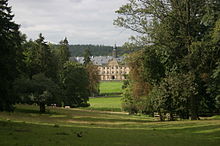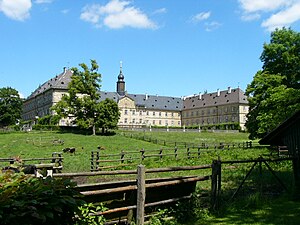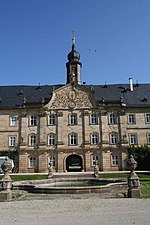Tambach Castle
The baroque Tambach Castle is the residence of the Counts of Ortenburg, built at the end of the 17th century . The castle, which is unusual in its complex, with its adjoining wildlife park is located in the Tambach district west of the community of Weitramsdorf in the Bavarian region of Upper Franconia- West on the federal highway 303 Coburg - Schweinfurt , 11 kilometers from Coburg.
history
Emergence
The origin of Tambach Castle goes back to the establishment of a monastery courtyard in the early 12th century near the small town of Tambach, whose name first appeared in a document in 1156. Already at that time, almost two kilometers northeast of Tambach, there was a branch of the Cistercian monastery Langheim near Lichtenfels in Altenhof , whose monks had long farmed carp in the area of the Tambach monastery and created a chain of ponds that still exist today. The monastery courtyard, which was built right next to the fish ponds, developed faster than the older one in Altenhof and rose to the position of monastery office in the 13th century, which around 100 years later was granted lower and even higher jurisdiction . A brewery was built on the west side of the now castle-like monastery courtyard , in which the Cistercian monks brewed their own beer under the direction of a master brewer who did not belong to the monastery and who lived together with the game master in the forester's house .
Destruction and new construction
Both in the Peasants 'War (1524 to 1525) and in the Thirty Years' War (1618 to 1648) the monastery courtyard and the brewery were almost completely destroyed. The rich mother monastery Langheim made a significant contribution to the rapid reconstruction, and at the end of the 17th century one began under the abbot Gallus Knauer , a nephew of Mauritius Knauer (* 1612, † 1664), formerly also Abbot of Langheim and the author of the famous centenarian Calendar to rebuild the former courtyard as a mighty baroque palace.
First, the eastern wing of the palace, on the left from the street, was completed in 1698. The architectural design is attributed to the then very busy Langheim monastery builder Leonhard Dientzenhofer , but this is not certain. The courtyard facing the park is unusual for a baroque palace. This is explained by the fact that the simpler west wing as a commercial wing should not point to the representation side , the street side. After half a century of complete restraint, Abbot Stephan Mösinger had the pavilion built to the right of the entrance gate on the street in 1746 . This abbot's coat of arms is emblazoned above the door. From 1777 to 1786, the middle wing and west wing were completed by Abbot Johann Nepomuk Pitius. His coat of arms adorns the northern central projecting gable .
The Counts of Ortenburg
During the secularization , the Langheim monastery and the monastery office in Tambach Castle were dissolved. The Wittelsbachers offered to exchange the County of Ortenburg (previously a Protestant island in the middle of their territory, which was a permanent nuisance) for the former church property in Franconia. With a contract dated August 14, 1805, the imperial county of Ortenburg was exchanged for the new county of Ortenburg-Tambach . On January 20, 1806, Count Joseph Carl zu Ortenburg-Tambach took possession of the new territory. The government lasted only a few months. As early as October 1806, the county was mediated in fulfillment of the Reichsdeputationshauptschluss and taken over again by Bavaria. Thus, the imperial county was downgraded to a state rule with some special rights. The count family lives at Tambach Castle to this day.

In the 19th and 20th centuries, the new owners added a lot to the building of the palace, which had largely been completed by the Langheimers. Count Franz Carl von Ortenburg had the palace complex redesigned. In 1892 the outer fronts of the utility wing with its narrow windows of the storage rooms and stables were adapted to the living area and habitable rooms were set up inside. Behind the small baroque garden on the courtyard side, an extensive landscape garden in the English style was created. In 1910 the western Heinrichstor was added as a counterpart to the eastern gate from 1698 with a broken gable and a figured niche. It is crowned by a cartouche with an inscription plaque and the Ortenburg coat of arms.
During the Second World War , in April 1943, part of the archive of the Reich Aviation Ministry and the naval archive were brought from Berlin to Tambach Castle. On April 11, 1945, soldiers of the Western Allies confiscated the document collection known as the Tambach Archive.
Furnishing
On both the street and the park side, the more than 100-meter-long front of the transverse wing is divided horizontally by the rows of windows on three floors and the central projection, which is divided into five axes by six pilasters . On the three central axes of the risalit there is a triangular gable on stilted ledge arches with a relief filling . The roof ridge above carries a slender roof turret with an onion dome and a lantern-like attachment with a golden cross. Until 1806 the courtyard was adorned by two fountains with figures by the Bamberg sculptor Michael Trautmann . After moving into the castle, the Ortenburgers had both removed and replaced by an oval water basin with a fountain . The fountain with the group of figures Jesus and the Samaritan now adorns the picturesque center of Neundorf's main square, while the other, of which only the obelisk remained, came to Hattersdorf and was rebuilt there in the middle of the village.
Only a few stucco ceilings and faience ovens remain from the old interior of the castle . One of them, it looks like a cupboard, turns out to be a heated ceramic stove on closer inspection. Most of the mostly baroque and rococo - inventory was of the places Burger Count from their abandoned ancestral castle in Passau brought. In addition to furniture, some of which are valuable, there are considerable pieces of old handicrafts and Altmeißner porcelain , including some Kaendler figures, and a multi-figure series of table centerpieces made of Sèvres porcelain , a gift from Napoléon Bonaparte to the Ortenburgers.
Castle Church
Tambach Castle owes the construction of the castle church to the abbot of Langheim Monastery, Johann Nepomuk Pitius, between 1777 and 1786. It is a rarity due to its pure Louis-seize style. The church, which goes through two floors of the central wing, is from the outside not recognizable as such and is located opposite the stairwell on the east side of the main entrance. Its creator was Lorenz Fink from Würzburg, then barely 30 years old. Abbot Pitius consecrated the church in 1786 against the will of the Bamberg prince-bishop , fell into disgrace and was dismissed in 1788 for wasting his office.
The church interior, which is rectangular in itself, is given the impression of a central area with a corridor on the ground floor and a gallery above, thanks to an oval column wreath . The white gold stucco, which, typical of the Louis Seize style, seems to float in the surfaces, is a work by Heinrich Seelmann . The light green panels create a cheerful, light room. Until 1806, the church was decorated with sculptures by the sculptor Michael Trautmann, the main altar carried a group of figures of the Assumption of the Virgin Mary and two side altars, figures of Saints Bernhard and Johann Nepomuk and the Annunciation group with worshiping angels.
The first count to live in Tambach, Josef Carl zu Ortenburg , had the church adapted to the evangelical rite in 1806 . A pulpit altar was added in place of the main altar , and Trautmann's figures of saints and the side altars were removed. Only the relief medallions with scenes from the life of the Virgin, held by stucco putti , have been preserved. The Assumption of Mary of the main altar is now in the parish church of the Birth of Mary in the Neundorf district, which also belongs to Weitramsdorf , the side altars were placed in the parish church of St. Sebastian in Autenhausen and in the branch church of St. John the Baptist in Witzmannsberg .
In 1954 the family returned to Ortenburg to the Catholic Church. The church building was renovated from 1956 to 1965 and adapted to the original rite. The pulpit was replaced by a Madonna sculpture . This depiction of the Blessed Virgin with the child on her lap and a grape in her hand from the middle of the 18th century comes from Ticino and is reminiscent of Italian models due to its Renaissance style .
Todays use
In 1969, the then lord of the castle Alram Graf zu Ortenburg (1925–2007) laid out a 50 hectare wildlife park in the English landscape garden created in the 19th century. The park was officially opened on May 16, 1970. The varied arrangement of spacious enclosures with European large and small game , fishing opportunities, children's playgrounds, riding opportunities and a nature trail have since attracted visitors from the wider area, especially during the autumn rutting season . The Bavarian Falconry is located in the wildlife park.
Across from the castle, the extensive grounds of the Coburg Golf Club were built in 1995, of which Alram Graf von Ortenburg was a founding member. The system with initially 9 lanes was expanded to 18 lanes in 1997.
The castle is still partly inhabited by the family zu Ortenburg, Heinrich Graf zu Ortenburg and his wife and is usually not open to the public. It houses the noble library of the Counts of Ortenburg, which has been decimated by recent sales around the world , from which the Berlin State Library acquired some Middle High German manuscripts through the antiquarian Jörn Günther. The castle is also home to the Hunting and Fishing Museum, a branch museum of the German Hunting and Fishing Museum in Munich, which has been closed since 2013.
As part of the “Tambach Summer”, a number of important concerts take place in the courtyard. Every second Sunday in September, the day of the open monument, some rooms of the castle and the castle church can be visited. On the third weekend of Advent of each year, a traditional Christmas market takes place in the castle courtyard, with some of the private rooms open to visitors. Exhibitions and concerts at Christmas round off the market.
- Picture gallery
literature
- Fritz Mahnke: Palaces and castles in the vicinity of the Franconian Crown, 1st volume . 3. Edition. Druck- und Verlagsanstalt Neue Presse GmbH, Coburg 1974, pp. 137–141
- Friedrich Hausmann : Tambach and the Counts of Ortenburg. In: Weitramsdorf - past and present. 1177-1977. From the story of a village. Weitramsdorf 1977, 276-288.
- Alram Graf zu Ortenburg : The Counts to Ortenburg in Tambach. In: Weitramsdorf - past and present. 1177-1977. From the story of a village. Weitramsdorf 1977, 289f.
- Alram Graf zu Ortenburg: Tambach Castle Wildlife Park. In: Weitramsdorf - past and present. 1177-1977. From the story of a village. Weitramsdorf 1977, 338f.
- Heinz Pellender: TAMBACH from the Langheimer Klosteramt zur Ortenburg'schen Grafschaft (= series of publications of the Historischen Gesellschaft Coburg eV, issue 3). Coburg 1985.
- Heinz Pellender: Tambach - from Langheim monastery office to Ortenburg'schen Grafschaft - history of the Count's House of Ortenburg, the monastery office and Tambach Castle . 2nd ext. Edition, Coburg 1990.
Web links
proof
- ^ Friedrich Hausmann : The Counts of Ortenburg and their male ancestors, the Spanheimers in Carinthia, Saxony and Bavaria, as well as their branch lines - A genealogical overview , 1994 p. 41
- ↑ http://projekte.geschichte.uni-freiburg.de/mertens/graf/privbib.htm ( Memento from March 8, 2012 in the Internet Archive ) http://www.ub.uni-dortmund.de/Listenarchive/LIB -L / 199911 / 19991103.html
Coordinates: 50 ° 13 ′ 59 ″ N , 10 ° 51 ′ 56 ″ E









